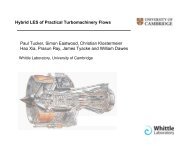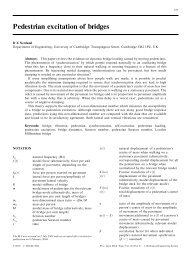Analysis of surface roughness of cold-rolled aluminium foil
Analysis of surface roughness of cold-rolled aluminium foil
Analysis of surface roughness of cold-rolled aluminium foil
You also want an ePaper? Increase the reach of your titles
YUMPU automatically turns print PDFs into web optimized ePapers that Google loves.
72 H.R. Le, M.P.F. Sutcliffe / Wear 244 (2000) 71–78<br />
Nomenclature<br />
f sampling frequency <strong>of</strong> <strong>surface</strong><br />
measurement, f=1/<br />
Fj<br />
(j=0,...,n/2−1) complex FFT coefficients <strong>of</strong> a<br />
data array<br />
hi (i=1,...,n) data array <strong>of</strong> <strong>surface</strong> heights<br />
hw<br />
smooth film thickness using the<br />
Wilson and Walowit formula<br />
H ( H ˜ ) matrix <strong>of</strong> <strong>surface</strong> heights (after<br />
low-pass filtering)<br />
s2 (λ1,λ2) <strong>surface</strong> variance <strong>of</strong> the wavelength<br />
between λ1 and λ2<br />
S single-sided power spectral density<br />
U average entraining velocity,<br />
U=(Ur+Us)/2<br />
¯w mean square <strong>of</strong> a window vector,<br />
¯w = wi 2 /n<br />
wi (i=1,...,n) window vector<br />
Y plane strain yield stress <strong>of</strong> the strip<br />
Greek symbols<br />
α oil pressure viscosity index<br />
θ 0 inlet angle between the strip and roll (radians)<br />
δ depth <strong>of</strong> pits<br />
∆ sampling distance <strong>of</strong> <strong>surface</strong> measurement<br />
η oil viscosity at ambient pressure<br />
λ wavelength <strong>of</strong> the <strong>surface</strong> spectrum<br />
σ r r.m.s. <strong>surface</strong> <strong>roughness</strong> on the rolls<br />
σ s r.m.s. <strong>surface</strong> <strong>roughness</strong> on the strip<br />
σ t combined r.m.s. <strong>surface</strong> <strong>roughness</strong> <strong>of</strong><br />
the strip and roll<br />
σ 2 (λ) variance <strong>of</strong> all wavelengths >λ<br />
flattening [10], in which the <strong>surface</strong> <strong>roughness</strong> is modelled as<br />
two wavelengths. Several authors have identified various features<br />
on the strip <strong>surface</strong>s. For example, Gjønnes [11] used<br />
laser-scanning microscopy to identify grooves, roll ridges<br />
and ‘shingles’ on <strong>cold</strong>-<strong>rolled</strong> <strong>aluminium</strong> while Ohkubo et al.<br />
[12] investigated the influence on the <strong>surface</strong> gloss <strong>of</strong> <strong>aluminium</strong><br />
<strong>foil</strong> <strong>of</strong> oil pits, ‘slags’, roll marks and small depressions.<br />
Staeves and Schmoeckel [13] relate the tribological<br />
behaviour to the <strong>surface</strong> topography. Ahmed and Sutcliffe<br />
[14] describe a method for analysing three-dimensional <strong>surface</strong><br />
topography obtained from <strong>cold</strong>-<strong>rolled</strong> stainless steel<br />
samples to identify hydrodynamic pits and roll marks on the<br />
<strong>surface</strong>, by considering the local differences in height between<br />
the pits and the un-pitted regions. This is particularly<br />
suited to the stainless steel case where pits are the dominant<br />
features. Although that method has been applied by Le<br />
and Sutcliffe [15] to the <strong>aluminium</strong> <strong>foil</strong> samples described<br />
in this paper, this paper describes a more efficient algorithm<br />
which is better suited to <strong>aluminium</strong> <strong>foil</strong> where roll marks<br />
are the dominant feature.<br />
The purpose <strong>of</strong> this paper is to look at the details <strong>of</strong> the<br />
<strong>surface</strong> <strong>of</strong> <strong>aluminium</strong> <strong>foil</strong> <strong>rolled</strong> under industrial conditions,<br />
to confirm the results <strong>of</strong> the laboratory-scale tests and to<br />
provide benchmarks for the theoretical models currently being<br />
developed. The spectral analysis <strong>of</strong> <strong>surface</strong> <strong>roughness</strong><br />
described in Ref. [16] is applied to the measured <strong>surface</strong><br />
data. Section 2 <strong>of</strong> this paper describes the details <strong>of</strong> the strip<br />
samples and measurements <strong>of</strong> <strong>surface</strong> <strong>roughness</strong>. Observations<br />
<strong>of</strong> the <strong>surface</strong> feature are described in Section 3. The<br />
methodology <strong>of</strong> spectral and hydrodynamic pit analysis is<br />
described in Section 4. Section 5 presents the results, and<br />
conclusions are given in Section 6.<br />
2. Experimental procedure<br />
2.1. Collection <strong>of</strong> samples<br />
A coil <strong>of</strong> 1200 <strong>aluminium</strong> alloy <strong>of</strong> initial strip <strong>of</strong> thickness<br />
0.4 mm was <strong>rolled</strong> under industrial conditions at a constant<br />
speed for the first pass and at a wide range <strong>of</strong> speeds for<br />
the second pass using freshly ground rolls. The reduction<br />
in strip thickness during both passes was ≈50%. Lubricant<br />
was applied abundantly on both sides <strong>of</strong> the strip. Samples<br />
<strong>of</strong> the initial strip were collected from the end <strong>of</strong> the coil.<br />
After the first pass, a sample was taken from a region where<br />
the coil was being <strong>rolled</strong> at speed. Changes in speed during<br />
the second pass were marked on the side <strong>of</strong> the coil. These<br />
were used to identify the rolling speed <strong>of</strong> samples that were<br />
collected from the middle <strong>of</strong> the coil, which was scrapped<br />
after this pass. Samples <strong>rolled</strong> with worn rolls under similar<br />
conditions were collected for comparison. Replicas <strong>of</strong><br />
the roll <strong>surface</strong> were taken before the second pass using<br />
Press-O-Film <strong>surface</strong>-replicating tape supplied by Testex.<br />
2.2. Measurements <strong>of</strong> <strong>surface</strong> <strong>roughness</strong><br />
Surface <strong>roughness</strong> was measured in a Zygo non-contacting<br />
three-dimensional interferometric pr<strong>of</strong>ilometer. The equipment<br />
has a lateral resolution <strong>of</strong> 0.5 m and vertical resolution<br />
<strong>of</strong> 0.1 nm.<br />
2.2.1. Preparation <strong>of</strong> samples<br />
It is very important to use flat samples, a problem that<br />
is especially relevant for thin <strong>foil</strong> and the replica tape. To<br />
ensure this, the samples are carefully cut, trimmed and stuck<br />
onto a glass slide. The <strong>surface</strong>s <strong>of</strong> the strip samples were<br />
cleaned with acetone to remove residual lubricant before<br />
measurements were taken.<br />
2.2.2. Measurements<br />
A20× objective lens was used to ensure that the field<br />
<strong>of</strong> view and depth <strong>of</strong> field are sufficient to take in the<br />
relevant <strong>surface</strong> features. For <strong>surface</strong> <strong>roughness</strong> measurements,<br />
a magnification <strong>of</strong> 200 is used. Normally, 10 areas are<br />
measured and averaged to give the average r.m.s <strong>roughness</strong>







